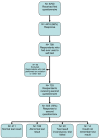How do people respond to self-test results? A cross-sectional survey
- PMID: 20942917
- PMCID: PMC2964597
- DOI: 10.1186/1471-2296-11-77
How do people respond to self-test results? A cross-sectional survey
Abstract
Background: Self-tests, tests on medical conditions that can be performed by consumers without consulting a doctor first, are frequently used. Nevertheless, there are concerns about the safety of self-testing, as it may delay diagnosis and appropriate treatment in the case of inappropriate use of the test, or false-negative results. It is unclear whether self-tests stimulate appropriate follow-up behaviour. Our aim was to examine the frequency of self-test use, consumers' response to self-test results in terms of their confidence in the result, reassurance by the test result, and follow-up behaviour.
Methods: A two step cross-sectional survey was designed. A random sample of 6700 Internet users in an existing Internet panel received an online questionnaire on the use of self-tests. Self-tests were defined as tests on body materials, initiated by consumers with the aim to diagnose a disease or risk factor. A second questionnaire on consumers' response to self-test results was sent to the respondents that were identified as a self-tester in the first questionnaire (n = 703).
Results: 18.1% (799/4416) of the respondents had ever performed a self-test, the most frequently used tests being those for diabetes (5.3%), kidney disease (4.9%), cholesterol (4.5%), urinary tract infection (1.9%) and HIV/AIDS and Chlamydia (both 1.6%). A total of 78.1% of the testers with a normal test result and 81.4% of those with an abnormal result reported confidence in this result. Almost all (95.6%) of the testers with a normal result felt reassured. After a normal result, 78.1% did not take any further action and 5.8% consulted a doctor. The corresponding figures after an abnormal test result were 9.3% and 72.2%, respectively.
Conclusions: Respondents who had performed a self-test seemed to base their follow-up behaviour on the result of the test. They had confidence in the test result, and were often reassured by a normal result. After an abnormal result, most self-testers sought medical care. Because consumers seem to trust the self-test results, further research should focus on the development of consumer information addressing indications for performing a self-test, the validity of self-tests and appropriate interpretation of and management after a test.
Figures
References
-
- Tebb KP, Paukku MH, Pai-Dhungat MR, Gyamfi AA, Shafer MA. Home STI testing: the adolescent female's opinion. J Adolesc Health. 2004;35(6):462–467. - PubMed
-
- Skolnik HS, Phillips KA, Binson D, Dilley JW. Deciding where and how to be tested for HIV: what matters most? Journal of acquired immune deficiency syndromes (1999) 2001;27(3):292–300. - PubMed
MeSH terms
LinkOut - more resources
Full Text Sources


